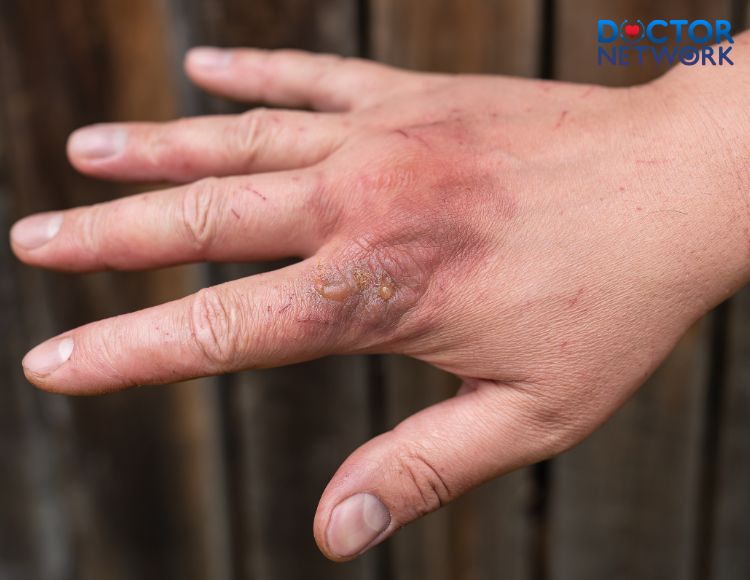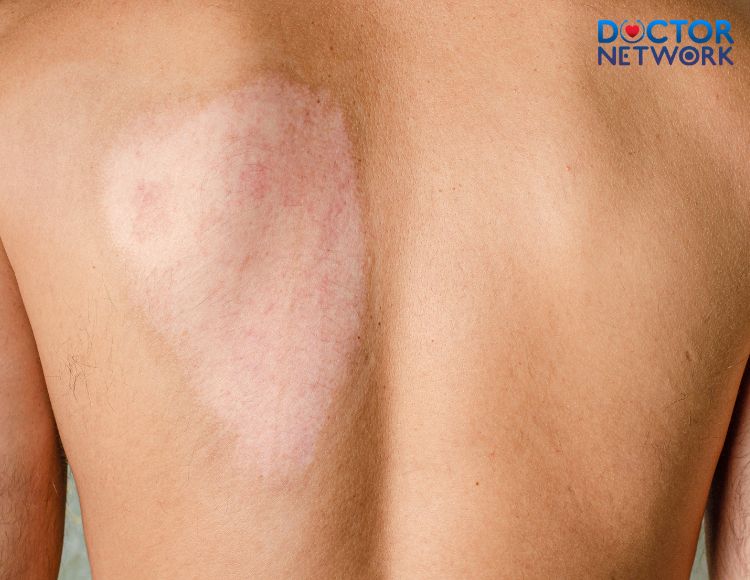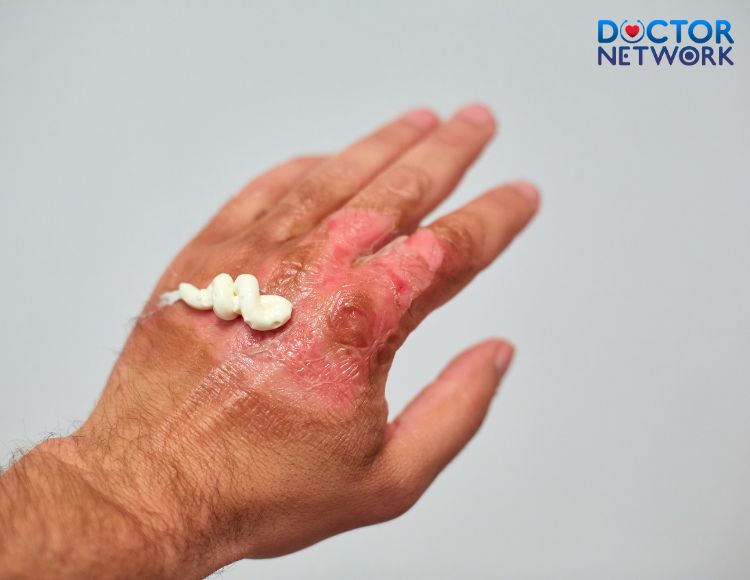Hyperpigmented burn scars are a variant of common skin injuries, characterized by a darkening of the affected area as a natural response of the body to burn injuries, which may even turn black. Beyond affecting the appearance of the skin, these darkened burn scars can pose additional health issues. This article explores the causes and treatments for hyperpigmented burn scars.
Causes of Hyperpigmented Burn Scars
High Temperature Exposure: One of the primary causes of hyperpigmented burn scars is exposure to high temperatures affecting the skin and underlying tissues. Contact with open flames, hot liquids, or chemicals can severely damage skin cells, leading to cell death and associated health issues, including burns.

The cause of dark burns is the impact of high temperature on the skin and subcutaneous tissue
Post-Healing Pigmentation: After a burn has healed, the affected area often exhibits hyperpigmentation. This is due to the accumulation of melanin in the skin cells around the burn area. Melanin is a naturally occurring pigment in the skin, and its overproduction can lead to darkening of the skin.
Increased Melanin Production Due to Skin Injury: Exposure to sunlight, fires, or chemical substances can also increase melanin production. When the skin is injured, the body often produces melanin as a protective measure against UV radiation and other harmful factors. However, excessive production of melanin can lead to skin darkening and hyperpigmented burn scars.
Understanding the causes of hyperpigmented burn scars can aid in the prevention and treatment of this condition in medical practice.
Symptoms and Signs of Hyperpigmented Burn Scars
Color Change: The primary symptom is a change in skin color in the affected area. Initially, the burn area may appear red and severely inflamed. However, post-healing, the skin may darken, sometimes turning black, primarily due to melanin accumulation.

Dark burns are also often accompanied by the appearance of scars and rough skin
Scar Formation and Rough Skin: Besides color change, hyperpigmented burn scars often come with scar formation and rough skin. Post-healing, the skin can form scars, especially in severe burn cases. Scars may be raised or indented, causing uneven skin surfaces and aesthetic concerns. The affected skin area may also become rough and uncomfortable.
Discomfort and Itching: Patients may experience discomfort and itching at the burn site. This could be due to the loss of skin flexibility and moisture after the injury, leading to uncomfortable sensations and impacting daily life quality.
Recognizing these symptoms is crucial for diagnosing and effectively treating hyperpigmented burn scars in medical practice.
Treatment and Prevention Measures
Sunscreen and Depigmenting Creams:
Using sunscreen daily is vital for treating and preventing hyperpigmented burn scars. It protects the skin from UV radiation, preventing melanin overproduction and minimizing skin darkening. Depigmenting creams can also help lighten burn scars and improve skin appearance.
Melanin Production Reduction Therapies:
Therapies aimed at reducing melanin production can help lighten hyperpigmented burn scars. These include creams containing hydroquinone, tretinoin, or alpha hydroxy acids, and laser therapy to reduce melanin production and lighten the skin.
Scar Reduction and Skin Improvement Methods:
For hyperpigmented burn scars with scar formation, scar reduction, and skin improvement methods are important. Treatments can include specialized creams, laser therapy, or surgery to remove scars. Maintaining skin moisture and using suitable skin care products can also improve damaged skin conditions and reduce darkening.
Combining these treatment and prevention measures can improve hyperpigmented burn scars and prevent their recurrence. However, consulting with a dermatology specialist is essential to ensure effective and safe treatment for patients.
Risks of Neglecting Treatment for Hyperpigmented Burn Scars
Neglecting treatment for hyperpigmented burn scars can lead to several severe health risks and issues. Primarily, these scars can increase the risk of infections and bacterial invasion, especially in cases with open wounds or infections. Additionally, the darkening of the skin can cause psychological and emotional discomfort for the patient, affecting their daily life quality and self-confidence.
Benefits of Proper Skin Care After Burns
Proper skin care after burns plays a crucial role in the recovery and treatment process of hyperpigmented burn scars. Maintaining clean skin and applying moisturizer daily not only helps keep the skin hydrated but also reduces the risk of infection and the darkening of burn scars. Moreover, avoiding direct sunlight and using sunscreen daily can protect the skin from UV radiation, preventing excessive melanin production and reducing the darkening of the burn scars.

Applying lotion every day not only helps keep the skin moisturized but also reduces the risk of infection and reduces the darkening of burns
Preventative Measures to Avoid Hyperpigmented Burn Scars
To prevent burns and hyperpigmented burn scars, implementing preventive measures is crucial. Firstly, avoiding exposure to high temperatures and toxic chemicals can reduce the risk of burns. Additionally, wearing protective clothing when working near potential burn hazards is an important preventive measure. Finally, enhancing knowledge about proper skin care after burns and seeking advice from medical professionals can help prevent and minimize the risks associated with burns and hyperpigmented burn scars.
In summary, timely care and treatment for hyperpigmented burn scars not only help reduce infection risks but also improve the patient’s life quality and confidence.
Scientific Evidence on “Hyperpigmented Burn Scars”
Below are some scientific references on “hyperpigmented burn scars”:
- The article “Post-inflammatory Hyperpigmentation: Causes and Treatments,” published in the journal Seminars in Cutaneous Medicine and Surgery in 2010, discusses the causes and treatments for post-inflammatory hyperpigmentation, including that caused by burns.
- A study published in the Journal of Burn Care & Research in 2015 showed that 80% of burn patients developed hyperpigmentation, indicating that such discoloration can persist for over two years.
- Research published in the journal Microcirculation in 2018 demonstrated that vascular damage from burns could lead to inflammation and increased skin pigmentation.
- A study in the journal Burns in 2020 revealed that burn scars could lead to increased skin pigmentation in more than 50% of cases.
Caring for and treating hyperpigmented burn scars is essential to minimize infection risks, improve the skin’s appearance, and enhance the patient’s quality of life. This article aims to assist in understanding and correctly treating such conditions to prevent subsequent infections.
References:
https://my.clevelandclinic.org/health/symptoms/24527-second-degree-burn
https://www.healthline.com/health/burn-scars
https://msktc.org/burn/factsheets/scar-management-after-burn-injury
Kiểm Duyệt Nội Dung
More than 10 years of marketing communications experience in the medical and health field.
Successfully deployed marketing communication activities, content development and social networking channels for hospital partners, clinics, doctors and medical professionals across the country.
More than 6 years of experience in organizing and producing leading prestigious medical programs in Vietnam, in collaboration with Ho Chi Minh City Television (HTV). Typical programs include Nhật Ký Blouse Trắng, Bác Sĩ Nói Gì, Alo Bác Sĩ Nghe, Nhật Ký Hạnh Phúc, Vui Khỏe Cùng Con, Bác Sỹ Mẹ, v.v.
Comprehensive cooperation with hundreds of hospitals and clinics, thousands of doctors and medical experts to join hands in building a medical content and service platform on the Doctor Network application.

























